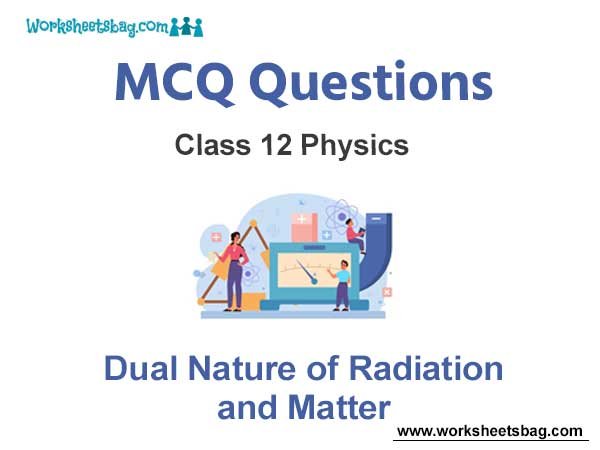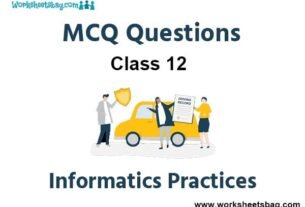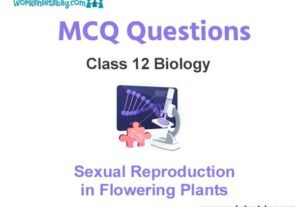Please refer to Dual Nature of Radiation and Matter MCQ Questions Class 12 Physics below. These MCQ questions for Class 12 Physics with answers have been designed as per the latest NCERT, CBSE books, and syllabus issued for the current academic year. These objective questions for Dual Nature of Radiation and Matter will help you to prepare for the exams and get more marks.
Dual Nature of Radiation and Matter MCQ Questions Class 12 Physics
Please see solved MCQ Questions for Dual Nature of Radiation and Matter in Class 12 Physics. All questions and answers have been prepared by expert faculty of standard 12 based on the latest examination guidelines.
MCQ Questions Class 12 Physics Dual Nature of Radiation and Matter
Question. Who evaluated the mass of electron indirectly with help of charge?
(a) Thomson
(b) Millikan
(c) Rutherford
(d) Newton
Answer
A
Question. In the phenomenon of electric discharge through gases at low pressure, the coloured glow in the tube appears as a result of
(a) collisions between the charged particles emitted from the cathode and the atoms of the gas
(b) collision between different electrons of the atoms of the gas
(c) excitation of electrons in the atoms
(d) collision between the atoms of the gas.
Answer
A
Question.. In a discharge tube ionization of enclosed gas is produced due to collisions between
(a) neutral gas atoms/molecules
(b) positive ions and neutral atoms/molecules
(c) negative electrons and neutral atoms/molecules
(d) photons and neutral atoms/molecules.
Answer
C
Question. J.J. Thomson’s cathode-ray tube experiment demonstrated that
(a) cathode rays are streams of negatively charged ions
(b) all the mass of an atom is essentially in the nucleus
(c) the e/m of electrons is much greater than the e/m of protons
(d) the e/m ratio of the cathode-ray particles changes when a different gas is placed in the discharge tube
Answer
C
Question. In a discharge tube at 0.02 mm, there is formation of
(a) Crooke’s dark space
(b) Faraday’s dark space
(c) both space partly
(d) none of these.
Answer
A
Question. Photoelectric emission occurs only when the incident light has more than a certain minimum
(a) power
(b) wavelength
(c) intensity
(d) frequency
Answer
D
Question. n photoelectric emission process from a metal of work function 1.8 eV, the kinetic energy of most energetic electrons is 0.5 eV. The corresponding stopping potential is
(a) 1.8 V
(b) 1.3 V
(c) 0.5 V
(d) 2.3 V
Answer
C
Question. In which of the following, emission of electrons does not take place
(a) thermionic emission
(b) X-rays emission
(c) photoelectric emission
(d) secondary emission
Answer
B
Question. A beam of cathode rays is subjected to crossed electric (E) and magnetic fields (B). The fields are adjusted such that the beam is not deflected. The specific charge of the cathode rays is given by
(a) B2/2VE2
(b) 2VB2/E2
(c) 2VE2/B2
(d) E2/2VB2
Answer
D
Question. Which of the following is not the property of cathode rays ?
(a) It produces heating effect.
(b) It does not deflect in electric field.
(c) It casts shadow.
(d) It produces fluorescence.
Answer
B
Question. Thermions are
(a) protons
(b) electrons
(c) photons
(d) positrons.
Answer
B
Question. A source of light is placed at a distance of 50 cm from a photo cell and the stopping potential is found to be V0. If the distance between the light source and photo cell is made 25 cm, the new stopping potential will be :
(a) V0/2
(b) V0
(c) 4V0
(d) 2V0
Answer
B
Question. When monochromatic radiation of intensity I falls on a metal surface, the number of photoelectrons and their maximum kinetic energy are N and T respectively. If the intensity of radiation is 2I, the number of emitted electrons and their maximum kinetic energy are respectively
(a) N and 2T
(b) 2N and T
(c) 2N and 2T
(d) N and T
Answer
B
Question. When ultraviolet rays incident on metal plate then photoelectric effect does not occur, it occurs by incidence of
(a) infrared rays
(b) X-rays
(c) radio wave
(d) micro wave.
Answer
B
Question. The figure shows a plot of photo current versus anode potential for a photo sensitive surface for three different radiations. Which one of the following is a correct statement?

Answer
A
Question. A 5 watt source emits monochromatic light of wavelength 5000 Å. When placed 0.5 m away, it liberates photoelectrons from a photosensitive metallic surface. When the source is moved to a distance of 1.0 m, the number of photoelectrons liberated will be reduced by a factor of
(a) 8
(b) 16
(c) 2
(d) 4
Answer
D
Question. A photocell employs photoelectric effect to convert
(a) change in the frequency of light into a change in the electric current
(b) change in the frequency of light into a change in electric voltage
(c) change in the intensity of illumination into a change in photoelectric current
(d) change in the intensity of illumination into a change in the work function of the photocathode.
Answer
C
Question. A photo-cell is illuminated by a source of light, which is placed at a distance d from the cell. If the distance become d/2, then number of electrons emitted per second will be
(a) remain same
(b) four times
(c) two times
(d) one-fourth.
Answer
B
Question. The number of photo electrons emitted for light of a frequency u (higher than the threshold frequency u0) is proportional to
(a) threshold frequency (u0)
(b) intensity of light
(c) frequency of light (u)
(d) u – u0
Answer
B
Question. A photoelectric cell is illuminated by a point source of light 1 m away. When the source is shifted to 2 m then
(a) each emitted electron carries one quarter of the initial energy
(b) number of electrons emitted is half the initial number
(c) each emitted electron carries half the initial energy
(d) number of electrons emitted is a quarter of the initial number.
Answer
D
Question. As the intensity of incident light increases
(a) kinetic energy of emitted photoelectrons increases
(b) photoelectric current decreases
(c) photoelectric current increases
(d) kinetic energy of emitted photoelectrons decreases.
Answer
C
Question. The work function of a photosensitive material is 4.0 eV. The longest wavelength of light that can cause photon emission from the substance is (approximately)
(a) 3100 nm
(b) 966 nm
(c) 31 nm
(d) 310 nm
Answer
D
Question. When the light of frequency 2u0 (where u0 is threshold frequency), is incident on a metal plate, the maximum velocity of electrons emitted is v1. When the frequency of the incident radiation is increased to 5u0, the maximum velocity of electrons emitted from the same
plate is v2. The ratio of v1 to v2 is
(a) 1 : 2
(b) 1 : 4
(c) 4 : 1
(d) 2 : 1
Answer
A
Question. Which of the following statement is correct?
(a) The photocurrent increases with intensity of light.
(b) The stopping potential increases with increase of incident light.
(c) The current in photocell increases with increasing frequency.
(d) The photocurrent is proportional to the applied voltage.
Answer
A
Question. Light of frequency 1.5 times the threshold frequency is incident on a photosensitive material. What will be the photoelectric current if the frequency is halved and intensity is doubled?
(a) Doubled
(b) Four times
(c) One-fourth
(d) Zero
Answer
D
Question. The photoelectric threshold wavelength of silver is 3250 × 10–10 m. The velocity of the electron ejected from a silver surface by ultraviolet light of wavelength 2536 × 10–10 m is [Given h = 4.14 × 10–15 eV s and c = 3 × 108 m s–1]
(a) ≈ 0.6 × 106 m s–1
(b) ≈ 61 × 103 m s–1
(c) ≈ 0.3 × 106 m s–1
(d) ≈ 6 × 105 m s–1
Answer
A, D
Question. When the energy of the incident radiation is increased by 20%, the kinetic energy of the photoelectrons emitted from a metal surface increased from 0.5 eV to 0.8 eV. The work function of the metal is
(a) 0.65 eV
(b) 1.0 eV
(c) 1.3 eV
(d) 1.5 eV
Answer
B
Question. For photoelectric emission from certain metal the cutoff frequency is u. If radiation of frequency 2u impinges on the metal plate, the maximum possible velocity of the emitted electron will be (m is the electron mass)

Answer
A
Question. Photons with energy 5 eV are incident on a cathode C in a photoelectric cell. The maximum energy of emitted photoelectrons is 2 eV. When photons of energy 6 eV are incident on C, no photoelectrons will reach the anode A, if the stopping potential of A relative to C is
(a) +3 V
(b) +4 V
(c) –1 V
(d) –3 V
Answer
D
Question. Number of ejected photoelectrons increases with increase
(a) in intensity of light
(b) in wavelength of light
(c) in frequency of light
(d) never.
Answer
A
Question. The potential difference that must be applied to stop the fastest photoelectrons emitted by a nickel surface, having work function 5.01 eV, when ultraviolet light of 200 nm falls on it, must be
(a) 2.4 V
(b) –1.2 V
(c) –2.4 V
(d) 1.2 V
Answer
B
Question. The work function of a surface of a photosensitive material is 6.2 eV. The wavelength of the incident radiation for which the stopping potential is 5 V lies in the
(a) Infrared region
(b) X-ray region
(c) Ultraviolet region
(d) Visible region.
Answer
C
Question. The cathode of a photoelectric cell is changed such that the work function changes from W1 to W2 (W2 > W1). If the current before and after changes are I1 and I2, all other conditions remaining unchanged, then (assuming hu > W2)
(a) I1 = I2
(b) I1 < I2
(c) I1 > I2
(d) I1 < I2 < 2I1
Answer
A
Question. When a metallic surface is illuminated with radiation of wavelength λ, the stopping potential is V. If the same surface is illuminated with radiation of wavelength 2λ , the stopping potential is V/4. The threshold wavelength for the metallic surface is
(a) (5/2)λ
(b) 3λ
(c) 4λ
(d) 5λ
Answer
B
Question. A photoelectric surface is illuminated successively by monochromatic light of wavelength λ and λ/2. If the maximum kinetic energy of the emitted photoelectrons in the second case is 3 times that in the first case, the work function of the surface of the material is (h = Planck’s constant, c = speed of light)
(a) 2hc/λ
(b) hc/3λ
(c) hc/2λ
(d) hc/λ
Answer
C
Question. The work functions for metals A, B and C are respectively 1.92 eV, 2.0 eV and 5 eV. According to Einstein’s equation the metals which will emit photoelectrons for a radiation of wavelength 4100 Å is/are
(a) A only
(b) A and B only
(c) all the three metals
(d) none.
Answer
B
Question. A certain metallic surface is illuminated with monochromatic light of wavelength, λ . The stopping potential for photoelectric current for this light is 3 V0. If the same surface is illuminated with light of wavelength 2λ , the stopping potential is V0. The threshold wavelength for this surface for photoelectric effect is
(a) λ/4
(b) λ/6
(c) 6 λ
(d) 4 λ
Answer
D
Question. Two radiations of photons energies 1 eV and 2.5 eV, successively illuminate a photosensitive metallic surface of work function 0.5 eV. The ratio of the maximum speeds of the emitted electrons is
(a) 1 : 4
(b) 1 : 2
(c) 1 : 1
(d) 1 : 5
Answer
B
Question. A photosensitive metallic surface has work function, hu0. If photons of energy 2hu0 fall on this surface, the electrons come out with a maximum velocity of 4 × 106 m/s. When the photon energy is increased to 5hu0, then maximum velocity of photoelectrons will be
(a) 2 × 107 m/s
(b) 2 × 106 m/s
(c) 8 × 106 m/s
(d) 8 × 105 m/s
Answer
C
Question. The threshold frequency for a photosensitive metal is 3.3 × 1014 Hz. If light of frequency 8.2 × 1014 Hz is incident on this metal, the cut-off voltage for the photoelectron emission is nearly
(a) 1 V
(b) 2 V
(c) 3 V
(d) 5 V
Answer
B
Question. When photons of energy hu fall on an aluminium plate (of work function E0), photoelectrons of maximum kinetic energy K are ejected. If the frequency of radiation is doubled, the maximum kinetic energy of the ejected photoelectrons will be
(a) K + hu
(b) K + E0
(c) 2K
(d) K
Answer
A
Question. According to Einstein’s photoelectric equation, the graph between the kinetic energy of photoelectrons ejected and the frequency of incident radiation is

Answer
D
Question. When light of wavelength 300 nm (nanometer) falls on a photoelectric emitter, photoelectrons are liberated. For another emitter, however, light of 600 nm wavelength is sufficient for creating photoemission. What is the ratio of the work functions of the two emitters?
(a) 1 : 2
(b) 2 : 1
(c) 4 : 1
(d) 1 : 4
Answer
B
Question. Photoelectric work function of a metal is 1 eV. Light of wavelength λ =3000 Å falls on it. The photo electrons come out with a maximum velocity
(a) 10 metres/sec
(b) 102 metres/ sec
(c) 104 metres/sec
(d) 106 metres/sec
Answer
D
Question. A 200 W sodium street lamp emits yellow light of wavelength 0.6 mm. Assuming it to be 25% efficient in converting electrical energy to light, the number of photons of yellow light it emits per second is
(a) 1.5 × 1020
(b) 6 × 1018
(c) 62 × 1020
(d) 3 × 1019
Answer
A
Question. A source S1 is producing, 1015 photons per second of wavelength 5000 Å. Another source S2 is producing 1.02 × 1015 photons per second of wavelength 5100 Å. Then, (power of S2)/(power of S1) is equal to
(a) 1.00
(b) 1.02
(c) 1.04
(d) 0.98
Answer
A
Question. Ultraviolet radiations of 6.2 eV falls on an aluminium surface. Kinetic energy of fastest electron emitted is (work function = 4.2 eV)
(a) 3.2 × 10–21 J
(b) 3.2 × 10–19 J
(c) 7 × 10–25 J
(d) 9 × 10–32 J
Answer
B
Question. The photoelectric work function for a metal surface is 4.125 eV. The cut-off wavelength for this surface is
(a) 3000 Å
(b) 2062.5 Å
(c) 4125 Å
(d) 6000 Å
Answer
A
Question. In a photo-emissive cell, with exciting wavelength l, the fastest electron has speed v. If the exciting wavelength is changed to 3λ/4 , the speed of the fastest emitted electron will be
(a) less than v(4/3)1/2
(b) v(4/3)1/2
(c) v(3/4)1/2
(d) greater than v(4/3)1/2
Answer
D
Question. The threshold frequency for photoelectric effect on sodium corresponds to a wavelength of 5000 Å. Its work function is
(a) 4 × 10–19 J
(b) 1 J
(c) 2 × 10–19 J
(d) 3 × 10–19 J
Answer
A
Question. If the kinetic energy of the particle is increased to 16 times its previous value, the percentage change in the de Broglie wavelength of the particle is
(a) 25
(b) 75
(c) 60
(d) 50
Answer
B
Question. Electrons used in an electron microscope are accelerated by a voltage of 25 kV. If the voltage is increased to 100 kV then the de-Broglie wavelength associated with the electrons would
(a) increase by 2 times
(b) decrease by 2 times
(c) decrease by 4 times
(d) increase by 4 times.
Answer
B
Question. Which one among the following shows particle nature of light?
(a) photoelectric effect
(b) interference
(b) refraction
(d) polarization.
Answer
A
Question. If we consider electrons and photons of same wavelength, then they will have same
(a) momentum
(b) angular momentum
(c) energy
(d) velocity.
Answer
A
Question. When a proton is accelerated through 1 V, then its kinetic energy will be
(a) 1 eV
(b) 13.6 eV
(c) 1840 eV
(d) 0.54 eV
Answer
A
Question. An electron of mass m and charge e is accelerated from rest through a potential difference V in vacuum. Its final velocity will be

Answer
A
Question. The de Broglie wave corresponding to a particle of mass m and velocity v has a wavelength associated with it
(a) h/mv
(b) hmv
(c) mh/v
(d) m/hv
Answer
A
Question. The kinetic energy of an electron, which is accelerated in the potential difference of 100 volts, is
(a) 416.6 cal
(b) 6.636 cal
(c) 1.602 × 10–17 J
(d) 1.6 × 104 J
Answer
A


